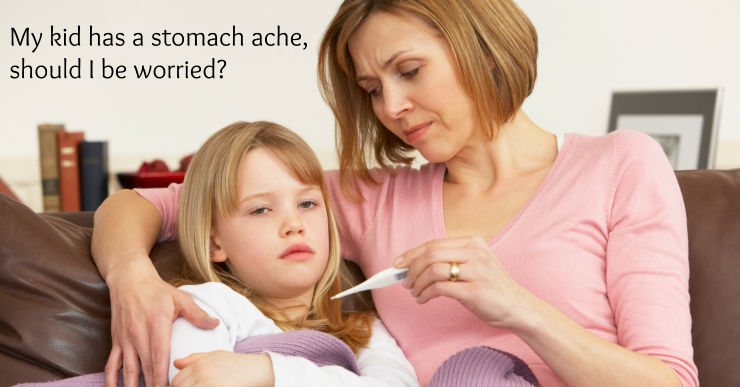My Kid Has A Stomach Ache, Should I Be Worried?
August 31, 2017
One of the most common ailments I treat in pediatrics is childhood stomach pain. In fact, at one point or another, all children will experience a stomach ache. I find that many of the parents I work with are unsure what to do when this happens. Since a stomach ache can be caused by anything from gas to appendicitis, I understand how it can be scary when your child comes to you complaining about stomach pain, and you don’t know what is causing it.
Because there are so many childhood conditions that can trigger stomach aches, I’m here to break down some of these conditions and provide guidance to better prepare you for the next time tummy pain strikes at your home.

Causes Of Stomach Ache In Children
In order to know what to do when your child has a stomach ache, let’s start by learning more about some of the most common causes of childhood abdominal pain.
Constipation
This is a major culprit of tummy trouble! Studies show that anywhere between 4-36% of children struggle with constipation and in the US alone, $3.9 billion is spent annual on health care resources for children struggling with this uncomfortable cause of stomach pain. When it comes to constipation, it’s not just about how many times your child poops. The frequency of bowel movements varies greatly from child to child and is also dependent on age (babies poop more than toddlers and older children). Focus on whether or not your child can pass stools easily. Bowel movements should not be painful. If your child is having hard, painful bowel movements, he or she is likely constipated.
If your child is complaining of abdominal pain, it’s always a good idea to ask them when they last had a bowel movement and encourage them to spend some time on the potty. The best way to manage constipation at home is by increasing your child’s water intake and giving them foods high in fiber (like these!).
Gastroenteritis
Stomach aches can signal the beginning stages of viral gastroenteritis. Gastroenteritis is often called the “stomach flu” even though it isn’t actually influenza. The usual symptoms of gastroenteritis are stomach pain, vomiting, diarrhea, and sometimes fever that last for about 24-48 hours. The main thing you want to be on the lookout for with gastroenteritis is dehydration symptoms, so make sure your child is drinking lots of fluids.
If your child has not urinated in 6-8 hours, very simply, it’s time for an immediate trip to your pediatric health provider or the emergency room. Otherwise, gastroenteritis can usually be managed at home as long as your child continues to drink water and stay hydrated.
Excessive Gas
One of the most common causes of stomach ache in children is overeating, gas pains, or other types of indigestion.
Excessive Gas Can Be Caused By:
- Swallowing Air: Babies often swallow air while they are eating or sucking on a pacifier. They can also swallow air while crying.
- Food: Let me start by typing the word that is on everyone’s mind: beans. Beans are notorious for causing gas. When you eat beans, the complex carbohydrates usually don’t digest completely and the bacteria in the large bowel will convert them into gas. Other foods that trigger gas are certain vegetables including asparagus, broccoli, brussels sprouts, cabbage, corn, some fruits, and whole grains like rice and oatmeal.
- Carbonated Drinks: The carbonation in soda can release gas in the stomach.
- Constipation and Diarrhea: Gas can build up when your child is constipated or increase with a bout of infectious diarrhea.
- Milk Intolerance: also known lactose intolerance, kids who have a milk intolerance have a hard time digesting milk sugar, and the undigested lactose can be converted into hydrogen by the bacteria in the large bowel. Other symptoms can include bloating, abdominal cramps, and diarrhea.
Excessive gas can usually be prevented by small changes in diet, including limiting gas-causing foods, and adding in a few high-fiber foods. If you think your child may have a milk intolerance, reduce the amount of dairy in his diet and make an appointment with your pediatric healthcare provider.
Bladder Infections
Children with bladder infections can present with stomach pain. Bladder infections can also occasionally cause children to vomit. If your child has stomach pain, ask them if they are having difficult or painful urination. If so, definitely take them to see your pediatric provider so their urine can be tested for a bladder infection.
Strep Throat
This is surprising to some, but often times children with strep throat will have stomach pain, nausea and sometimes vomiting. The same bacteria that causes throat pain in children who have strep can cause abdominal symptoms, too. If your child has stomach pain along with a sore throat and fever, or if they have a history of strep throat, take them to your pediatric provider so they can have a throat swab performed to test them for strep throat.
Worried Stomach
In children and adults, the most common cause of recurrent abdominal pain is stress and worries. This happens in over 10 percent of children. Pain from a worried stomach is usually localized in the middle of the stomach (near the belly button). This kind of pain is usually mild, but it’s still very real.
If your child isn’t experiencing any other symptoms along with their stomach pain, sit down and have a chat about their day to see if worry or anxiety may be the cause. Sometimes a few soothing words from mom or dad and a little extra love are exactly what this pediatric nurse practitioner orders!
That being said, if your child’s stomach pain becomes recurrent, make an appointment to have him or her checked out by your healthcare provider to make sure there aren’t any other underlying causes for the pain. If the diagnosis is a worried stomach, relaxation exercises may be helpful along with talking about triggering feelings and events. A pediatric mental health specialist can help you if your healthcare provider orders further treatment for worry or anxiety.
Tracking Recurrent Stomach Pain
If your child has reoccurring stomach pain for any reason, it’s a good idea to keep a log of when the stomach aches happen as well as what food/drink was consumed and any other symptoms they are experiencing. This will help you and your healthcare provider pinpoint any patterns or similarities in the days when your child is having pain.
The more details you track the better! Tracking when your child’s stomach pain happens, how long it lasts, the intensity of the pain, what happened before the pain, and what/if anything helped the pain to go away will truly help your pediatric provider determine the culprit of the stomach pain to find the best treatment.
Printable Tummy Tracker
Snag this printable tummy tracker to help you keep track of all the stomach ache details, so you don’t have to try to remember what you served for lunch three weeks ago on a Tuesday afternoon!
Click Here to Download your Tummy Tracker!
When Should I Call The Nurse About Stomach Pain?
I listed just a few of the most common causes of childhood abdominal pain above, but there are still many other causes. While most stomach aches will easily resolve themselves with a little time, fluids, and extra love, there are instances where you need to visit your pediatric healthcare provider. Just remember, if you unsure whether your child’s stomach pain warrants an appointment, it is always better to go in and have them checked.
One great test you can do with young children who are experiencing stomach pain is to sit them in your lap, or have them lay down, and press on their belly. You should be able to press an inch or so in with your fingers in all parts of the belly without resistance. Children’s bellies should be soft. If your child pushes your hand away or screams, or if the belly is also bloated and hard, it’s a good idea to call your healthcare provider. Here are a few more things to look out for…
Call your pediatric healthcare provider immediately if your child has stomach pain and:
- The pain is severe (causes constant crying)
- Your child holds their abdomen and walks bent over
- The pain is constant and lasts more than 2 hours
- The pain comes and goes (cramps) and lasts more than 12 hours
- Any blood has appeared in bowel movements
Go to the hospital if your child has stomach pain and:
- Is extremely lethargic (very weak or limp)
- Your child refuses to walk at all due to pain
- Your child has blood in their vomit
- Your child’s abdomen was recently injured
- Your child could have been poisoned by ingesting a plant, medicine, or chemical
What About Appendicitis Symptoms?
I know there is one word some of you were quickly scanning to find because you have a question I haven’t answered yet — “Is this stomach pain appendicitis?“ Most of the time, a child’s stomach ache isn’t from appendicitis, but it is always a possibility.
Appendicitis happens when your appendix is inflamed, usually due to a blockage or obstruction. If an inflamed appendix is not treated, it can rupture, causing a life-threatening situation. The usual treatment for appendicitis is antibiotics and surgery to remove the appendix. It is very understandable why parents would be concerned about this diagnosis.
I have a post that breaks down appendicitis symptoms and gives tips on what to look for if you think your child’s appendix is causing their stomach pain. Check it out and learn what you need to know about appendicitis here.

How To Treat A Stomach Ache At Home
You’ve determined that you don’t need to take a trip to the hospital for your child’s stomach ache. That’s great. But what do you do next?
Here are a few things you can do to treat a stomach ache at home:
- Encourage your child to lie down and rest. This is a great time to let them read a good book or watch a favorite movie. A good two hours of rest can make a huge difference.
- Give your child clear fluids. Water is best, but you can also offer them a flat soft drink (like 7Up).
- If constipation is the cause for your child’s stomach ache pain, let them spend a little time sitting on the toilet. Passing a stool can help to relieve the pressure and pain.
- Upper abdominal pain can be caused by indigestion. If your child is over 5 years old, and experiencing pain from indigestion, an over the counter antacid (like Children’s Tums) can be helpful. Follow the dosage instructions on the package.
- Be prepared for vomiting. Have a bucket or trash can at the ready in case it is needed. Younger children usually say “stomach ache” when they mean nausea.
- Avoid pain medication if your child doesn’t have a fever. Medication could make stomach pain worse, so it’s best to stay away from it if your child doesn’t have a fever over 102 degrees. (For more information on fevers, check out these fever facts)
- A whole lot of love. And cuddles, if your child wants them.
Track your child’s stomach pain with my printable tummy tracker. Note any new symptoms that may appear and how long the pain lasts. If the pain persists, or gets worse over 24 hours, you will want to have that information ready when you give the nurse a call.
Click Here to Download your Tummy Tracker!
Author: Dani Stringer, MSN, CPNP, PMHS – founder of KidNurse and MomNurse Academy